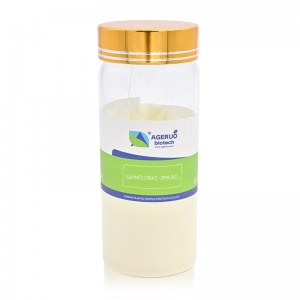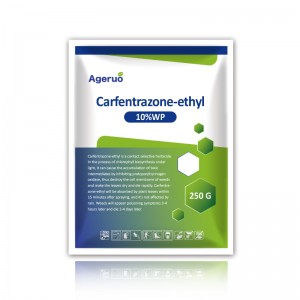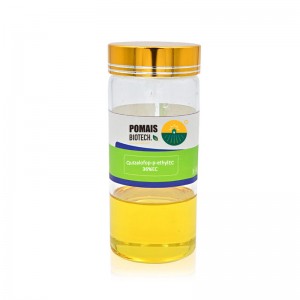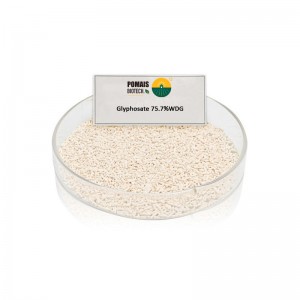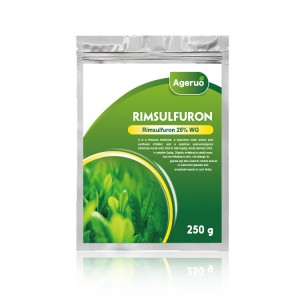Products
POMAIS Crop Protection Herbicide Quinclorac 25% SC
Introduction
| Active ingredients | Quinclorac |
| CAS Number | 84087-01-4 |
| Molecular Formula | C10H5Cl2NO2 |
| Application | It has a good effect on controlling barnyard grass in rice fields |
| Brand Name | POMAIS |
| Shelf life | 2 Years |
| Purity | 25% SC |
| State | Powder |
| Label | Customized |
| Formulations | 25% 50% 75% WP; 25% 30% SC; 50% SP |
| The mixed formulation products | Quinclorac 25% +Terbuthylazine 25% WDG
Quinclorac 15%+ Atrazine25% SC |
Mode of Action
Quinclorac acid belongs to quinoline carboxylic acid herbicide. Quinclorac is a selective herbicide used to control barnyard grass in rice fields. It belongs to hormone type quinoline carboxylic acid herbicide and is a synthetic hormone inhibitor. The medicament can be quickly absorbed by the germinating seeds, roots, stems and leaves, and rapidly transmitted to the stems and tops, causing weeds to die of poisoning, similar to the symptoms of auxin substances. It can effectively control barnyard grass in direct seeding field, and has good control effect on barnyard grass in 3-5 leaf period.
Role in sensitive grass weeds
In sensitive grass weeds (e.g. barnyardgrass, big dogwood, broadleaf signalgrass, and green dogwood), Quinclorac causes accumulation of tissue cyanide, inhibits root and shoot growth, and causes tissue discoloration and necrosis.
Suitable crops:

Act on these Pests:

Using Method
|
Formulations |
Crop names |
Weeds |
Dosage |
usage method |
|
25% WP |
Rice field |
Barnyardgrass |
900-1500g/ha |
Stem and leaf spray |
|
50% WP |
Rice field |
Barnyardgrass |
450-750g/ha |
Stem and leaf spray |
|
75% WP |
Rice field |
Barnyardgrass |
300-450g/ha |
Stem and leaf spray |
|
25% SC |
Rice field |
Barnyardgrass |
1050-1500ml/ha |
Stem and leaf spray |
|
30% SC |
Rice field |
Barnyardgrass |
675-1275ml/ha |
Stem and leaf spray |
|
50% WDG |
Rice field |
Barnyardgrass |
450-750g/ha |
Stem and leaf spray |
|
75% WDG |
Rice field |
Barnyardgrass |
450-600g/ha |
Stem and leaf spray |
|
Rape field |
Annual grass weeds |
105-195g/ha |
Stem and leaf spray |
|
|
50% SP |
Rice field |
Barnyardgrass |
450-750g/ha |
Stem and leaf spray |
Effectiveness against barnyard grass
Quinclorac is effective against barnyardgrass in rice paddies. It has a long application period and is effective from the 1-7 leaf stage.
Control of other weeds
Quinclorac is also effective in controlling weeds such as raindrops, field lily, watercress, duckweed, soapwort and so on.
Common Formulations
Common dosage forms of Quinclorac include 25%, 50%, and 75% wettable powder, 50% soluble powder, 50% water-dispersible granule, 25% and 30% suspension, and 25% effervescent granule.
Soil Residues
Residues of Quinclorac in soil are mainly through photolysis and degradation by microorganisms in the soil.
Crop Sensitivity
Certain crops such as sugar beets, eggplants, tobacco, tomatoes, carrots, etc. are very sensitive to Quinclorac and should not be planted in the field the following year after application, but only after two years. In addition, celery, parsley, carrots and other umbelliferous crops are also very sensitive to it.
Getting the right application period and dosage
In the rice-planting field, barnyard grass 1-7 leaf period can be applied, but need to pay attention to the amount of active ingredient mu, the water will be drained before the drug, the drug after the release of water back to the field and maintain a certain water layer. The direct field needs to be applied after the seedling 2.5 leaf stage.
Adopt the correct application technique
Spray evenly, avoid heavy spraying, and make sure the amount of water is sufficient.
Pay attention to weather conditions
Avoid high temperature during spraying or rain after spraying, which may cause flooding over the heart of the seedlings.
Symptoms of drug damage
In case of drug damage, the typical symptoms of rice are onion heart seedling (the heart leaves are rolled longitudinally and fused into onion tubes, and the tips of the leaves can be unfolded), the new leaves can not be extracted, and the new leaves can be seen rolled inward when peeling off the stalks.
Treatment measures
For the paddy fields that have been affected by the drug, measures can be taken in time to promote the recovery of seedling growth by spreading compound zinc fertilizer, spraying foliar fertilizer or plant growth regulator.
FAQ
How do you guarantee the quality?
Why Choose US
1.We supply varies of products with design,production,exporting and one stop service.
2.Optimal shipping routes selection to ensure delivery time and save your shipping cost.
3.We cooperate with customers all over the world, ans provide pesticide registration support.



